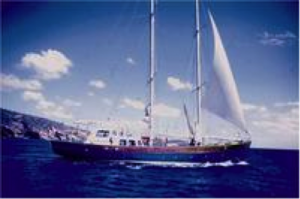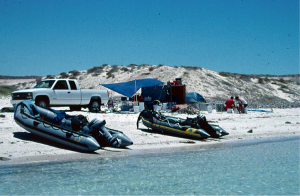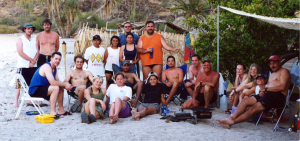By Mike Foster (28 August 2015)

Warm seas, cardóns at the shore, whales, turtles, boobies, rhodoliths, naked rocks, fish tacos, crema de cacti – it is no surprise that the Gulf of California has long attracted MLML scientists. We follow the tradition of early Gulf adventures including the famous Ricketts and Steinbeck expedition, and the seaweed studies of E. Yale Dawson. Dawson is particularly noteworthy as he was affiliated with the Beaudette Foundation, precursor to MLML, which sponsored a number of expeditions to the Gulf using the chartered vessel Neptunus Rex. Early on the MLML created a course, “Ecology of the Gulf of California,” centered on a series of cruises in the Gulf on the ship Makrele in 1969. Among the students participating were Genny Bockus (now Anderson), Shane Anderson, Jim Houk, Jim Norris, Don Wobber and Dave Mayer who all went on to notable careers in marine science.
The completion of the Baja Trans-peninsular Highway in 1973 greatly improved vehicle access to the Gulf and Pacific Baja, stimulating various informal expeditions by MLML faculty Greg Cailliet (sharks), Jim Harvey (whales), John Oliver (whale feeding) and Bernd Würsig (marine mammals). As is the MLML tradition, numerous students were included.

I became Baja bound in 1989 as the result of a phone call from Diana Steller, calling from Mulegé and asking if I knew anything about subtidal beds of purple-pink balls she had discovered while snorkeling in Bahía Concepción. It turned out these were rhodoliths, free-living non-geniculate coralline algae. Dawson had previously published on their taxonomy in the Gulf but little was known about their distribution and ecology in Baja or elsewhere in the world. Sounded interesting and I needed a break from the post-earthquake MLML blues. So it began – trips with other grad student volunteers to help with what became Diana’s MS theses on rhodolith bed ecology. This led to re-establishing the Gulf of California ecology course, now led by Diana, that includes various biological and geological studies depending on faculty interest, with a number of students going on to do their MS theses in Baja.
A highlight has been a collaboration with Rafael Riosmena Rodríguez that began in 1994-95 when I was on a Fulbright at Universidad Autónoma de Baja California Sur in La Paz. Rafael, now a professor at UABCS, subsequently came to MLML to do his MS on rhodolith taxonomy, went on to a PhD in Australia, and continues to collaborate on research in Baja. His students have frequently joined the MLML Baja class and various research projects. The collaboration also led to founding the International Rhodolith Workshop that convenes every three years, the 5th held in Costa Rica in 2015.

Part of the success of these forays into Baja is due to John Douglas (JD) and the rest of the Marine Ops staff who made sure the outboards and boats performed well, and who provided mandatory maintenance lectures if they returned abused.
No doubt MLML Baja adventures will continue with good science, collaboration, and excellent crema de cacti.

